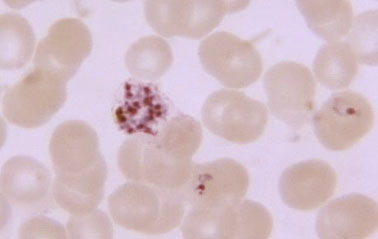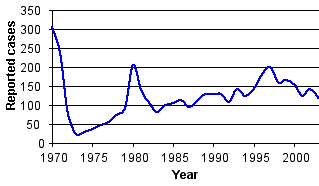| Malaria is characterized by chills and fever and
often by vomiting and severe headache. These symptoms typically
appear at intervals of 2-3 days, alternating with asymptomatic
periods. Malaria occurs wherever the mosquito vector Anopheles
is found and there are human hosts for the protozoan parasite
Plasmodium.
It is estimated that malaria affects 300-500 million people worldwide
and causes 2-4 million deaths annuals. Actually, there are probably
more people dying of malaria today than 30 years ago. It is returning
to areas where it had been nearly eradicated, such as eastern
Europe and central Asia. Africa, where 90% of the mortality from
the disease occurs, suffers the most from malaria. It is estimated
that it kills an African child every 30 seconds.
The disease was once widespread in the United States but effective
mosquito control and a reduction in the number of human carriers
caused the reported cases to drop before 100 by 1960. In recent
years, however, there has been an upward trend in the number of
U.S. cases, reflecting a worldwide resurgence of malaria, increased
travel to malarial areas, and an increase in immigration from
malarial areas.
Much effort is being expended on the search for an effective
vaccine. Unfortunately, the vaccine would have to be effective
against the four most common species of Plasmodium and against
te red blood cell stage (merozoite), the plasma and liver stage
(sporozoite), and the sexual stage (gametocyte).
Life cycle of the malaria parasite
|
|
Merozoites being released from lysed red blood
cell.
|
|
New cases of malaria reported in the U.S. |
|
Procedure
Eradiation of malaria is not in sight. Your task is to determine
the most effective control measures currently available and answer
the following questions in your report. You do not need to keep
within a budget.
1. Can malaria be eradicated by using only one of the four options
over 5 years?
a) If so, which one?
b) If not, describe what happened when each option was used alone
and try to explain the results.
2. Curative activities are directed at the cure of a malaria
victim. Preventative activities are intended to prevent healthy
individuals from getting malaria. Can malaria be eradicated by
using only curative measures? That is, setting up hospitals and
administering drugs to the ill? Describe the results of using
such a plan.
GO
TO THE MALARIA PROGRAM
|

